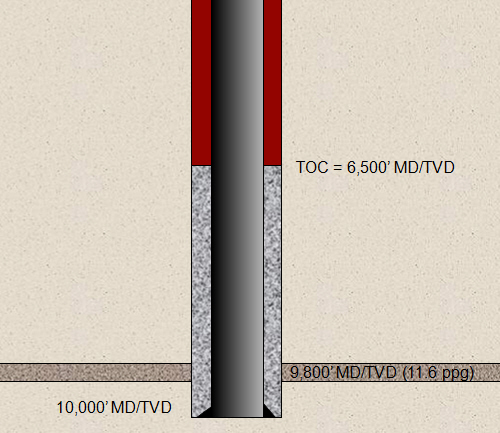When cement is in transition period (forming the bond), you will lose some hydrostatic pressure because cement becomes solid phase, therefore only water in the cement will provide hydrostatic pressure. In many cases happened, there is no issue while performing the cement job, however; once the cement is set after period of time, there is a casing pressure indicating that there is hydrocarbon in the annulus.
This example will demonstrate you why the well is in underbalance condition while waiting on cement.
Well information: Previous 9-5/8” casing shoe at 4000’ ft.
The vertical well (8.5” hole) is drilled to TD at 10,000ft with 12.1 ppg mud and the pay zone is at 9,800’ TVD with reservoir pressure of 11.6 ppg. The cement is planned to cover 3,500 ft in the annulus above the casing shoe. Water used to mix cement is 8.3 ppg weight.

Will the well go underbalance during the cement in transition period?
Formation pressure at 9,800 ft
Formation pressure at 9,800 ft = 0.052 x 11.6 x 9800 = 5,911 psi
Total hydrostatic pressure in the annulus
Hydrostatic pressure of drilling mud at 6,500 ft = 0.052 x 12.1 x 6,500 = 4,090 psi
When cement in transition period, only water in cement will provide hydrostatic pressure. So we can calculate hydrostatic pressure of water in cement
Hydrostatic pressure of water in cement = 0.052 x (9800 – 6,500) x 8.3 = 1,424 psi
While cement is in the transition period, total hydrostatic pressure in the annulus is equal to hydrostatic pressure of mud plus hydrostatic of water in cement
Total hydrostatic pressure in the annulus = 4,090 + 1,424 = 5,514 psi

You will see that during the transition period total hydrostatic pressure in the annulus is less than formation pressure therefore the well. For this case, the well will flow during transition period.

References
Coleman, S. (2018). Well Control Quiz Online. [online] Well Control Quiz Online – Test Your Well Control Knowledge for Free. Available at: http://wellcontrolquiz.com/ [Accessed 2 Aug. 2018].
Cormack, D. (2007). An introduction to well control calculations for drilling operations. 1st ed. Texas: Springer.
Crumpton, H. (2010). Well Control for Completions and Interventions. 1st ed. Texas: Gulf Publishing.
Grace, R. (2003). Blowout and well control handbook [recurso electrónico]. 1st ed. Paises Bajos: Gulf Professional Pub.
Grace, R. and Cudd, B. (1994). Advanced blowout & well control. 1st ed. Houston: Gulf Publishing Company.
Watson, D., Brittenham, T. and Moore, P. (2003). Advanced well control. 1st ed. Richardson, Tex.: Society of Petroleum Engineers.








Nice sharing you got here, really help me to understand flow after cement job while check valves on shoe is fails, can I use it on my writes ?
I’ll entitled your website for my writes
Regards
Mufti Ghazali
Excellent example of under balance situation while WOC